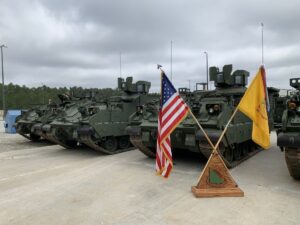The Army on Monday achieved its “first unit equipped” milestone for the new Armored Multi-Purpose Vehicle (AMPV), as the service is also set to make a full-rate production decision on the BAE Systems-built vehicle before the end of March.
Officials told reporters on Tuesday the Army is working toward a new goal of annually delivering “a brigade and a half” worth of AMPVs within two years, which would include BAE Systems increasing production from 12 to around 16 vehicles per month.

“The AMPV is a major piece of Army modernization,” Maj. Gen. Glenn Dean, program executive officer for ground combat systems (PEO GCS), said in a statement. “The platform offers soldiers better protection and survivability, and completing First Unit Equipped is a major milestone that could not have been accomplished without the entire Army and industry team.”
BAE Systems’ AMPV is the Army’s replacement for its legacy M113 armored personnel carriers, with initial deliveries to the 1st Armored Brigade Combat Team, 3rd Infantry Division at Fort Stewart in Georgia completed on Monday.
Jim Schirmer, the deputy PEO GCS, confirmed to reporters a full-rate production decision for BAE Systems is planned to be announced before the end of the month, as the Army works toward fielding a fleet of around 3,000 AMPVs.
“Those negotiations are ongoing. And we don’t have to complete those negotiations before a decision is made. So right now, before the end of this month we’ll have a full-rate production decision. And I anticipate it to be positive,” Schirmer said.
The Army on March 2 awarded BAE Systems a $245.6 million deal for the purchase of “early order materials” to support the upcoming first full-rate production deal, which Schirmer said ensures the production line can keep humming while we negotiate the contract” (Defense Daily, March 3).
Gen. James McConville, the Army chief, has previously cited the AMPV replacing the M113 as an example of replenishing inventories of equipment sent to Ukraine with upgraded capabilities rather than buying “new old stuff” (Defense Daily, Jan. 18).
Schirmer said the push to increase the AMPV production goal from a brigade to a “brigade-and-a-half” per year is “driven by the need to get more vehicles faster to replace what we’re providing to Ukraine.”
“We’ve benefited from pretty generous supplemental funding from Congress. And so, we’ve shipped several hundred M113s over to Ukraine to support that effort there. And the intent is to backfill that inventory with new vehicles, with AMPVs,” Schirmer said. “Because of the additional supplemental funding to backfill the M113s that we’re drawing down from the inventory, the new goal is a brigade-and-a-half. And [that] is what we believe is the capacity at the [BAE Systems] plant in York, [Pennsylvania].”
The Army’s FY ‘23 budget and subsequent supplemental funding bills cover procurement of 197 AMPVs, according to Lt. Col. Nate Costa, the product manager for AMPV, with the emergency Ukraine spending measures cover 154 of those vehicles.
The Army’s budget request for FY ‘24, detailed on Monday, includes plans to buy 91 vehicles next fiscal year (Defense Daily, March 13).
Schirmer also addressed previous challenges the AMPV program has faced, adding the Army is “pretty confident” that BAE Systems has worked through earlier production issues.
“We did have a lot of struggles in the beginning and we’re pretty confident now that the prime contractor BAE [Systems] has worked through that. They’ve been delivering on time for the majority of the past year and the quality problems that we were seeing early on have largely been corrected. At this point, we’re pretty satisfied with where we are,” Schirmer said.
Costa also detailed the steps BAE Systems is taking at its York, Pennsylvania production facility to ensure it can handle the max capacity for 16 AMPVs per month within years.
“For the BAE [Systems] production expansion, there’s a few things that they’re looking at. There’s additional space required for both where they do the machine and welding as well as where the assembly goes. So BAE’s identified space claims at their York production facility where they can expand the AMPV production line. But that also requires moving some other programs that are currently there based on what they determine they need to do for that aspect. And then, they’re looking at purchasing additional welding robots,” Costa said. “And then they’re increasing their paint booth capability as well, which helps on the output for the vehicles once they’re received by the Army. And also tied into all that is personnel growth too for both the assembly and the fabrication lines for AMPV.”
Schirmer noted he expects AMPV to be in production for about 15 to 20 years as the Army builds out its fleet.